Mine had a disposable filter in place of the strainer. It plugged and starved me of power. Just remember, the strainer is a coarse clean before things get to the filter.
After plumbing back in the strainer, replacing the filters, and replacing a bunch of the fuel line with clear line from Belmetric, I had a hard time starting it. Couldn't find anything wrong with the strainer, and no leaks from it(It is the lowest point in the system, so if it leaked air, it would leak fuel). So I checked the fuel filters and although I had tightened them with fresh copper washers and fresh hollow bolts. I loosened the bolts, spun the washers a few times, and tightened them down more. That was the last time I had to prime it.
Like FLU farm, mine will start even after sitting for weeks with a momentary press of the starter. The easiest diesel I have ever had.
I have been busy with other tasks. I removed the loader. I had to use a torch to heat the bolts and use the loader hydraulics because the 1" impact couldn't get the 1 1/4" bolt loose.
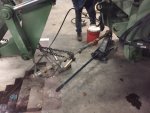
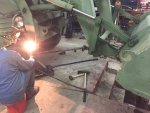
got a bunch of parts plated, and yesterday I removed the backhoe off Mog #1 and today I removed the backhoe from Mog #2. BH #1 will go on Mog #2 as the cylinders leak less. Since #1 was not running, it was removed from the upright position, not resting in the 3 point position. #2 had leaked out all the fluid and I did not want to give it fresh fluid to leak out, so it was removed from the same position. I will let you know how the reinstall goes...
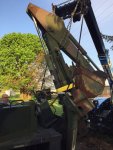
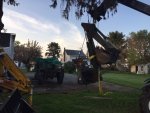
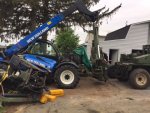
A couple of answers to questions asked:
Can you drive without the loader on? Yes, as long as the backhoe is stowed, I did not notice any poor handling with the loader off. In fact I preferred it. Back end squats a little bit, but not bad. Note, I am not running the Michelin 12.5R20's. I am running Sand Trail 12.5R20's on drum brake wheels with 1.5" extra offset.
Weight of the unimog without the loader or backhoe is 9740lbs!
LF 2940 RF 2865
LR 1920 RR 2025
I don't know the weight of the backhoe or loader alone, yet. {edit: I got those weights:
https://www.steelsoldiers.com/threads/flu419-see-hmmh-hme-owners-group.115476/post-2017346 }
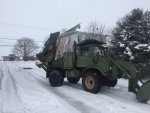
BLEED YOUR BRAKES! Mine worked fine, but the master cylinder caps had cracks and despite the hood being on, water had contaminated the system.
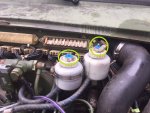
These caps (0004315433) off a 1969 Mercedes 250 fit:
http://www.ebay.com/itm/360972485654 but obviously get rid of the low fluid alert and will improperly mark the system for DOT4. I used a sharpie to Black out the Dot4 on the new caps.
How to bleed the brakes: I ended up making a pressure bleeder that I hooked to the bleeder screws on the master cylinder.
http://www.ibmwr.org/ktech/pressure-bleeder/bleeder.shtml Much faster than pumping the pedal, or a vacuum bleeder.
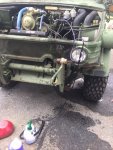
I bought a gallon of the proper DOT5 off ebay and bleed until I saw fresh purple fluid. The stuff in there was nasty.
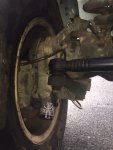
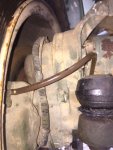
Whether to tilt the cab, or remove it. Tilting the cab is not an easy job, but neither is removing the cab. However, if you tilt it, you don't have to bleed the brake system afterwards. So tilt it.
How to attach the cab tilt brackets I sell. Remove the cab shock absorbers at the front of the cab and loosen the rubber cab mounts. Remove the rear cab mounts and jack up the back of the cab ~2". Slip a piece of 2x4 between the rear cab mount and frame. Then remove the front cab mount and use a pry bar to lift the front of the cab. If you skip the 2x4 under the rear cab mounts, you risk the rear window hitting the backhoe latch and breaking. You will see two nuts welded to an angled piece of metal on each side where the front cab mounts were.
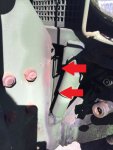
Bolt the tilt brackets to these angled plates.
Left Side:
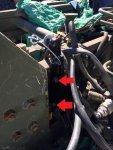
Right Side:
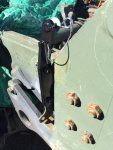
For thorough instructions, refer to the manual. Use a 2x4 cut to length to wedge the cab so it can't fall on you while you are working under the tilted cab.
















![DSCN0366[1].jpg DSCN0366[1].jpg](https://www.steelsoldiers.com/data/attachments/463/463811-58e91042f2d98bf921596a12d432b316.jpg)
![DSCN0369[1].jpg DSCN0369[1].jpg](https://www.steelsoldiers.com/data/attachments/463/463812-9d924bd6fc773a8108e590b15593cdc7.jpg)